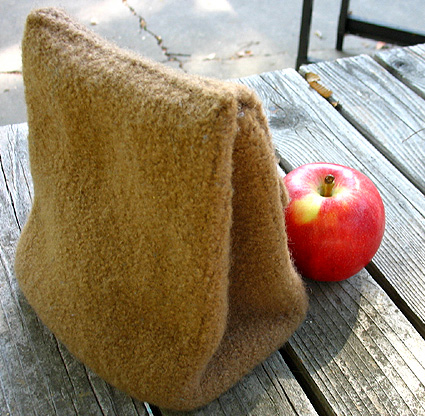This bag is beautiful! It was offered as a free pattern on the domestic sphere blog (she's moved on and no longer maintains the blog.) But what a cute purse ~ and the directions are detailed and easy to follow for a bag that looks more complicated that it is.
Felted Bag with Mitered Squares
MATERIALS
5 skeins Noro Kureyon [100% wool; 100m per 50g skein]; colorways 124 and 128
1 US size 10 [6mm]circular needle [or size to obtain gauge]
2 bamboo purse handles
stitch markers
GAUGE
13 sts and 26 rows = 4" in garter stitch.
SIZE
15 x 15 x 5 inches prior to felting
9 x 11 x 3.5 inches after felting

DIRECTIONS
The purse is worked in one piece beginning with the bottom. The diagram below shows the order in which the mitered squares that make up the bag are knit. Mitered squares are worked all in garter stitch. Even rows are worked plain, On each odd row, a double decrease is worked at the center -- this creates the square.
BOTTOM OF BAG
Cast on 32 sts using a knitted or cable cast on.
SMALL SQUARE
Row 1: K14, K2tog, place marker, K2tog, K14.
Row 2 and all following even rows: Knit.
Row 3 and all following odd rows: Knit to 2 sts before marker, K2tog, slip marker, K2tog, knit to end of row.
When 2 sts remain, remove marker and K2tog. Do not bind off last stitch.
To work second small square:
From the live stitch, pick up 15 more stitches along one side of the square [one stitch per garter ridge]. 16 sts on needle. Cast on 16 additional stitches using cable cast on -- 32 sts.
Work these 32 sts to create a second small square.
Repeat this process once again to create a third square in line with the first two.

FRONT AND BACK OF BAG
Beginning with the remaining live stitch, pick up 23 additional stitches along one long side of the bag's bottom, one stitch per garter row. The last stitch you picked up should be at the center of the piece. Cast on an additional 24 stitches [48 sts on needle].
Work the large square as you did the small one:
LARGE SQUARE
Row 1: K22, K2tog, place marker, K2tog, K22.
Row 2 and all even rows: Knit
Row 3 and all remaining odd rows: K to 2 sts before marker, K2tog, slip marker, K2tog, K to end of row.
Work a second large square above the first. This time, break yarn and pull through last st to secure.
Go back to the bottom of the bag and pick up 24 sts along the bottom of bag and 24 sts along the first large square. Work these 48 sts as described for the large square.
When this square is finished, work another above it to complete the first side of the bag. Break yarn and secure it by pulling through the last stitch.
Work the back as you did the front with 4 large squares. Referring again to the diagram for the order of squares.

SIDES OF BAG
The sides of the bag are worked in double-mitered squares which look like U shapes. The technique is very similar to the technique used above.
Beginning at the point where the bottom and front of the bag meet, count back 16 garter ridges from the bottom of the bag. Pick up 16 sts from the front of the bag, 16 sts along the bottom of the bag and 16 sts from the back of the bag.
Row 1: K14, k2tog, place marker,k2tog, k12, k2tog place marker, k2tog, k14.
Row 2 and all even rows: Knit.
Row 3 and all remaining odd rows: K to 2 sts before first marker, k2tog, slip marker, k2tog, knit to 2 sts before second marker k2tog, slip marker, k2tog, k to end of row.
When there are no longer any stitches left between the two markers, K 1 even row, then use a three needle bind off to seam remaining sts together. Break yarn and secure.
Work a second and third U above the first. The third U should come to the top of the bag.
Work the second side panel the same on the remaining side.
FINISHING
Decide which is the wrong side of the bag and work in all ends on the wrong side.
If desired, pick up 128 sts along the top of the bag (one for each stitch or garter ridge) and knit a couple of rows, then bind off loosely.
FELTING
Place finished bag in a zipped laundry bag and toss into the washer with a pair of old jeans. Put washer on "hot", "small load" and "heavy duty" settings. I ran mine through the wash cycle twice and allowed the bag to be spun out.
Block bag on appropriately sized box. and allow to dry thoroughly. This may take a couple of days.
Sew handles in place with appropriately colored heavy duty thread or yarn. Noro Kureyon is not particularly strong, so it may not be the best choice for sewing on the handles.











































